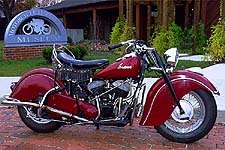Road Test: 1946 Indian Chief - Motorcycle.com
Columbus, Ohio, November 3, 2000 -- Contrary to popular belief, it is possible to have a blast going ten miles per hour. The catch, however, is that it helps to be riding the Holy Grail of cruisers.
MO got some saddle time on the enigmatic Indian Chief during the 2001 Gold Wing press introduction. As the week-long event drew to a close, a group of Honda officials and journalists stopped at the Motorcycle Hall of Fame Museum, located on the grounds of the American Motorcyclist Association headquarters in Pinkerington, Ohio.
Following an entertaining and informative tour, museum executive director Mark Mederski fired up a blood-red 1946 model especially for us.
Much to our surprise, the Chief sounded a lot closer to a 650 cc Yamaha V Star we recently tested than any Harley. For a twin, the exhaust note was smooth and high pitched. It almost had a lawnmower quality to it, but it definitely meant business.
Mederski took a few warm-up laps around the museum parking lot, finally rolling to a graceful halt. He then handed the bike over to the few brave souls willing to risk wadding a piece of motorcycle history (not to mention a fair bit of pride).
After a week spent flogging the latest Gold Wing, it was fun watching a group of expert riders struggle with the left-foot clutch and suicide shifter. It's also worth note that neither the clutch nor the throttle had spring returns. This meant that wherever you left them last is where they stayed."Harley was one way, Indian was another and never the twain shall meet," In morbidly comical fashion, a few killed the engine, a few ground the gears, another performed a mini burnout while one unfortunate soul took an unintended excursion up a curb and through a flower bed. Miraculously, the bike and rider remained upright. Only the highway bars sustained any scrapes.
As awkward as the controls were, however, it could have been much worse. On most old Indians, Mederski explained, the hand controls are reversed. Imagine trying to twist the throttle with your left hand while shifting with the right hand!
Dan Smith, resource development director for the museum, said there are two main reasons for the unusual control layout.
The first, many believe, was the fierce competition between Indian and Harley-Davidson. This caused designers to purposefully make it difficult to switch from one brand to the other.
"Harley was one way, Indian was another and never the twain shall meet," Smith said.
The second reason was that Indians were widely used for police duty. Controlling the throttle with left hand, Smith explained, freed the right hand to fire a weapon.
Smith also noted that the slang term "suicide" has evolved to describe the hand shifter. In reality, it refers to the foot-operated clutch.
To illustrate this point, imagine being stopped at a red light on a hill. You are balancing the bike with your left foot and holding the bike on the hill with the right foot brake. When the light turns green, you have to lift your left foot off the ground to engage the clutch. Unless you can get the bike rolling in time, you likely would fall over.
"Trying to start the bike on a hill was like suicide," Smith said.
The good news was that we were on level ground and this particular bike featured a configuration (optional from the factory) which placed the shifter on the left and the throttle and front brake on the right. The left grip governed the aforementioned spark advance (a function controlled automatically on modern bikes).
For this MO writer (thankfully), metal, rubber, dead dinosaur and human flesh coexisted in zen-like harmony. A gingerly twist of the throttle and careful treatment of the clutch and soon we were rolling.
Small compared to today's cruisers, the 550 pound Indian maneuvered with surprising ease and perfect balance. The seating position was accurately described by one Honda official as "proud."
Shifts were a bit challenging, however. To engage first, you'd shove (not ease) the shift lever forward. A pull back yielded neutral, then second and finally third. Aside from sticking tape markers on the fuel tank, there really wasn't a way to know if the lever was in the desired position. You just had to believe.
So, we admit, this isn't a real road test. We got nothin' for you in terms of dragstrip times, fastest laps at Willow Springs or 60-to-zero braking figures. What we can say is that everyone who stepped off the Chief wore a huge grin (even the flower-bed bound rider). Chalk it up to mystique. Attribute it to a symbiotic rider/bike relationship that rivals machines a half-century newer. Credit bold yet timeless style.
And, who cares about the bizarre starting ritual, little splatters of oil everywhere and waves of heat emanating from the motor. These trivial things melted away from consciousness. All that remained was the fact we were in the presence of motorcycle perfection. Our curiosity almost ruined the experience, however. Inquiring about this specific machine, we learned that in the realm of Chiefdom, this example was a bit of a dog. It was in beautiful shape, but many parts (such as the rims) were not original.
Mederski also revealed that Indian Chiefs are not particularly rare. Our own research indicates the Chief was introduced in 1922 and produced all the way into the 1950s. Furthermore, they easily can be located and purchased for roughly the same cost as a well-equipped Harley-Davidson Road King.
But, we say vintage value be damned! The Chief is cool and if you ever have a chance to ride one, do not pass it up. Just don't ask the nice folks at the Motorcycle Hall of Fame Museum for a spin.
More by Motorcycle Online Staff






























Comments
Join the conversation